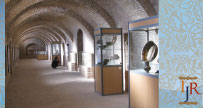
LED in art gallery/museum application
Recent years, the quality of life around the world increases, people pay more attention to the beauty of life experience, but also want more art into daily lives. The lighting system of the art galleries and museums is one of the key to highlight the arts, crafts, folk heritage during exhibition period. The choice of lighting should consider the conservation of the artifacts, energy saving, display effects, and business sales (sale at venues such as art galleries, and the reproductions at museum). In addition to energy saving LED lighting compared to other lighting methods (such as: incadescenct, fluorescent, halogen lamps, etc.) has the absolute advantage, as well as the outstanding performance about the artifacts conservation and exhibition effects:
- In artifacts conservation: According to many years research about the conservation techniques, scientists believe that the over illuminance and UV/IR spectrum is one of the culprits to the optical damage. Commission International de l’Eclairage (CIE) publised "Control of Damage to Museum Objects by Optical Radiation" by CIE Technical Committee 3-22 Div 3 at 2004, as referring as CIE157-2004. Based on the characteristics of material surface (where the pigments and substrates count), 4 levels of responsivities have been proposed, as listed in the Table.

- In performance of the exhibition, the colour rendering capability of the light source at low illuminance level dominates the subjective assessments. Roughtly, it can be assorted into 3 major domains as objective, artifact and subjective factors:
At 1990s, Cuttle et al. has proven that the tri-band light source cause less damage to the artifacts, and the subjective assessment of the colour rendering capability shown that the tri-band light source is close to the white light. Prof. Fuchida (Joshibi University of Art and Design, JP) and his team performed a series of experiments and shown that LED-RGB module have better colour rendering capability under low illuminance level, and RGB cause less damage. Getty museum (LA, USA) applied LED lighting in one of the exhibitions with high responsibity artifacts. Due to that LED shows better lighting control capability, high colour rendering and less UV/IR spectrum, it become an ideal light source for art gallery and museum.
(1) Objective factor: Under different illuminance conditions (e.g., spectral, illuminance level, etc), the recognized colour space by human vision can be differnt. Regarding to the colour discrimination among the colour space, there are several famous models can be aplied, such as CIEXYZ(1931) with Ra/CRI, CIECAM02 with nCRI etc. Scientists suggested the CIECAM02 should be applied in the art gallery /museum due to the low illuminance level.
(2) Artifact factor: The dominated colours, shape and subject of the artifacts would influence the preference of colours/lightings of the observers. Unless a special case, artists often use the sunlight as the illuminance source during their creation. Hence the standard D65 (6500K) can be used as a good reference, which is supposedly able to represent the art creating scenario. However, the conventional D65 light sources (non-LED) generate high ratio of blue-UV spectral which is bad for the conservation purpose. The exhibition of the modern museum applies lower CCT, such as 3600 or 4500K. Literature shows that the lighting with lower CCT can present better for gouache, oil painting, etc. However, about 1000K lower CCT is prefered for the 3D artifacts, such as sculptures. If the subject of the artifacts are related to the evening, love, family, a low CCT lighting is prefered due to established impressions of the observers.
(3) Subjective (Observer) factor: It contains the local culture, society, education and age of the observers. For instance, the prefered CCT at private space differs at eastern and western world. From the research published at 2015, the 20-25 young people (including engineering and art/design background) from China and Taiwan assess the warmth of the museum condition much differently.
Although the narrow bandwidth, more colourful light source can be applied from LED technologies. Based on CIE157-2004, the damage of the artifact can be reduce 5 times when the LED technology could be retrofited from conventional lighting. Comparing to the direct sunlight, the damage ratio reduces more than 80 times. Additionally, the digitial control of the LED technologies enalbes the colorful and lively interpreation of the colour of the artifacts. Hence the LED is positive to art gallery/museum.
The Pacific Northwest National Laboratory (PNNL), on behalf of the U.S. Department of Energy (DOE), the Getty Conservation Institute (GCI), and the Canadian Conservation Institute (CCI), investigated the use of the Guidelines for the benefit of both the museum and SSL communities. 979 questionnaires were successfully sent to members of the museum community who had requested a copy of the Guidelines, yielding 46 sets of responses (a 4.7% response rate). Compared with over 55% of museum workplaces still using incandescent in 2009, 51% of the responders also identified incandescent as the principal lighting type, with LED at 40%, compact fluorescent (CFL) at 13%, linear fluorescent (FL) at 11%, and others (including metal halide, halogen, daylight) at 22%. The main difference between 2009 and 2014 lies in the higher percentage of LED adoption, now up to 40% compared to almost none. The full text of the report can be download from the GATEWAY program of DoE.
According to the previous discussion, LED lighting in art gallery and museum requires companies with full skills (including light source, control, power, etc) and ambition to success.
